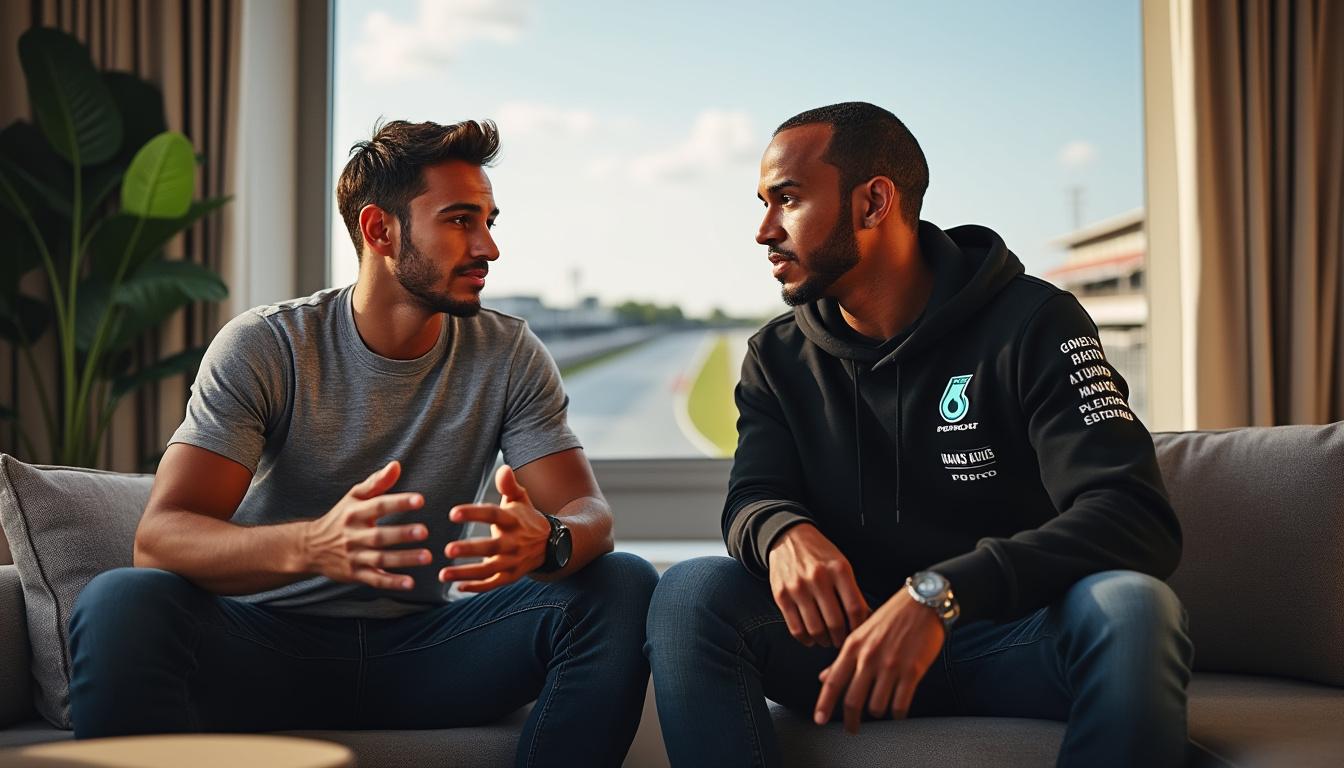The roar of the engines, the smell of burning rubber, and the thrill of competition—this is the world of Formula 1. Every race season brings new challenges, and for young talents, stepping onto the grid alongside established legends can be both exhilarating and intimidating. George Russell’s journey to Mercedes is a perfect example of this duality.
As he transitioned from Williams to Mercedes, Russell found himself not just racing against his peers but going wheel-to-wheel with the legendary Lewis Hamilton. The pressure was immense, considering Hamilton’s dominance in the sport over the previous years. Russell shared his thoughts on this daunting challenge during a candid conversation on the Untapped podcast, where he opened up about the psychological adjustments he needed to make. The mental game in Formula 1 is as crucial as the physical one, especially when competing against someone who has tasted success time and again. Russell’s encounters with a psychologist provided him with a fresh perspective that transformed his mindset, and it’s this transformative journey that reveals insights into the intricacies of racing at the highest level.

George Russell’s rise in Formula 1 has been nothing short of remarkable, particularly as he steps up to the challenge of racing alongside the formidable Lewis Hamilton at Mercedes. Their dynamic in the team not only shapes race outcomes but also serves as a fascinating study in psychology and performance under pressure. Recently, Russell opened up about how a conversation with his psychologist profoundly influenced his approach to racing, especially in relation to competing against Hamilton.
Russell, who joined Mercedes after a successful stint at Williams, faced an uphill battle stepping into a team that had built itself around Hamilton, a seven-time world champion. The transition from the lower grid to racing alongside one of the sport’s greatest was, in his words, like “climbing the ladder.” This monumental shift came with its own set of pressures and self-doubt, leading Russell to seek psychological support to find clarity and confidence in a highly competitive environment.
In his conversations with his psychologist, Russell confronted the pressure of being Hamilton’s teammate. He noted, “When I walk into the garage… I’m putting my helmet on. I’m in control of my own destiny.” This mantra emphasizes the importance of self-belief and the understanding that, regardless of Hamilton’s success, Russell must focus on his performance. The discussion served as a pivotal moment that allowed him to mentally prepare for the intense scrutiny and competition that awaited him.
How did Russell’s mindset shift following the discussion?
One of the most significant changes in George Russell’s mindset was his acceptance of the reality of competing against Hamilton. Previously, he viewed himself through the lens of his performance against past teammates, boasting a remarkable statistic of finishing ahead in 95% of his races with them. However, the prospect of racing against Hamilton necessitated a recalibration of these expectations. He wisely realized that achieving a similar success rate against the “GOAT” would not be feasible. Russell articulated this shift by stating, “If I beat him 55% of the time over a year, that’s amazing.”
This newfound perspective was liberating, enabling him to set realistic goals while acknowledging Hamilton’s unparalleled experience and skill. He grasped the importance of individual performance without being overly consumed by the need to dominate every race. By adopting this mindset, Russell not only released some pressure but also redirected his focus to becoming the best version of himself, rather than merely trying to outshine his world champion teammate.
Moreover, this self-awareness plays a crucial role in Russell’s growth. Acknowledging that he won’t win every race frees him to learn and adapt, treating each race as a unique opportunity to improve. This psychological resilience will undoubtedly serve him well throughout his career in F1.
What are the challenges Russell faces in the Mercedes team?
Joining Mercedes and racing alongside Lewis Hamilton presents an array of challenges for George Russell. The enormity of the task cannot be underestimated; Hamilton’s dominance in F1 is now legendary. The entire team ethos is built around his strategies, preferences, and racing style, which can be intimidating for any new driver stepping into those shoes. Indeed, Russell recognized this dynamic during his transition, expressing his understanding that entering a championship-winning team like Mercedes involves navigating intricacies that go beyond driving skills.
He articulated that it wasn’t just a challenge of speed; it was about adapting to the established culture and learning to collaborate effectively with a driver renowned for his meticulous work ethic and insight into car performance. Russell remarked that the environment is intensely competitive, yet it’s also one that fosters growth. In high-stakes situations such as qualifying or race days, the pressure can be twofold—displaying talent while also fitting within a well-tuned machine.
The psychological challenges are noteworthy as well. Russell must continuously assert his presence amidst the reputation and achievements of Hamilton. This duality requires a mental sharpness that can only be attained through experience and self-assuredness. Russell’s conversations with his psychologist have undoubtedly equipped him with the tools to navigate these pressures while maintaining focus on his performance.
How does Russell’s experience compare to Hamilton’s history?
Understanding each driver’s journey provides context for Russell’s current experience. Lewis Hamilton’s rise to the top of Formula 1 is marked by an extraordinary combination of talent, hard work, and mental fortitude. With multiple championships to his name, Hamilton has faced immense competition—some from legendary drivers, others from new challengers attempting to displace him. Hamilton built his legacy on understanding his car, his competitors, and managing the psychological aspects of each race.
In contrast, Russell’s journey is relatively recent. Spending his initial years with Williams, he gained invaluable experience racing against seasoned competitors, but the challenge in Mercedes presents a different level of difficulty. While he has proven records against previous teammates, competing directly against Hamilton represents a step into the unknown. It’s a testament to Hamilton’s impact on the sport that new drivers must adjust not only their driving strategies but also their mindset around his legacy.
Bringing these experiences together reveals the stark differences in how each driver approaches racing. Russell’s current phase involves learning from Hamilton while fighting to carve out his identity in the sport. He seeks to step out from the shadow of Hamilton’s illustrious career, which presents both psychological barriers and opportunities for growth.
Strong mental preparation, like what Russell has engaged in, becomes essential, reinforcing the notion that mental performance can be just as crucial as driving skills in high-pressure racing scenarios. In the long run, how Russell handles this rivalry will shape not only his career but also the dynamics of future racing in Mercedes.
What implications does Russell’s growth have for the future of Formula 1?
George Russell’s development at Mercedes highlights the evolving landscape of Formula 1 and the critical role of psychological readiness in performance. His journey illustrates the importance of mental toughness and self-management for aspiring drivers, demonstrating that success involves more than just technical skill; it is also intertwined with the mindset.
As the sport continues to attract new talent, the strategies employed by drivers like Russell—using psychological insights to bolster their competitive edge—set a precedent for a new generation. These approaches could encourage upcoming racers to seek similar support, fostering a culture of mental health awareness within the sport. Additionally, these strategies emphasize not only performance but also personal growth, which resonates with fans and aspiring racers alike.
Moreover, as Russell continues to adapt and find success, the implications extend beyond individual performance. His relationship with Hamilton could redefine what teamwork looks like in the competitive world of Formula 1 racing. With two talented drivers pushing each other to excel, the Mercedes team could potentially experience unprecedented levels of competitiveness, ultimately benefiting the overall narrative of the sport.
As we watch their rivalry unfold, the lessons gained from Russell’s insights echo broadly—success is layered, bolstered by psychological resilience, self-awareness, and continual adaptation in a relentless pursuit of excellence.
Through the lens of this dynamic, Formula 1 promises to remain an exhilarating sport, with every team battle teaching drivers—and fans—about the nuances of competition, both on and off the track.


